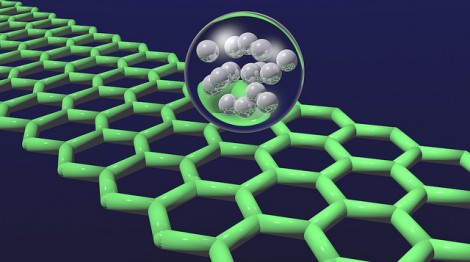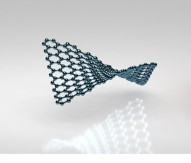
Growing graphene
The Graphene Flagship is part of the EU’s Future and Emerging Technologies (FET) scheme, which, according to the European Commission, seeks to “turn Europe’s excellent science base into a competitive advantage by uncovering radically new technological possibilities”. Specifically part of the FET Flagships, the graphene project aims to develop “a new class of material beyond the era of silicon” and was announced as a winner of a competitive process in 2013.
In April, Portal travelled to Manchester, UK, to attend the Commercial Graphene Show 2015. On the sidelines of the event, Professor Andrea Ferrari, chairman of the executive board of the flagship, detailed to Portal the significant steps the EU had taken in funding graphene, the importance of attracting more industrial players to participate in the project, and its latest developments. In an interview following his keynote address, Ferrari began by outlining a short history of the development of this nanomaterial, before detailing some of the recent progress in the field of graphene and related layered materials.
“Graphene was known for decades before the groundbreaking physics experiments in Manchester in 2004. What happened there ten years ago is that fundamental physics experiments in graphene exfoliated from bulk graphite were performed, and proof was given that charge carriers live in a two-dimensional world in this material. This led to the 2010 Nobel Prize in Physics.
“Before 2004-2005, the graphene field was niche. It then suddenly took the limelight, especially in the field of fundamental physics. Many physicists saw this material as a playground that they could use without going to CERN to carry out their experiments.
“The interest in graphene has exploded, though it was only in 2008-2009 that researchers really began to realise that the material can be useful in many applications. During the last ten years, many advances have happened in lab experiments – almost every day, every week we have seen major new advances in physics, in devices, and in the understanding of the fundamental properties of this material and the over 500 related two-dimensional materials.”
Key investment
In January 2013, the then European commissioner for the Digital Agenda, Neelie Kroes, announced that ‘Graphene’ had been selected as one of the two winning FET Flagship projects. The Graphene Flagship would receive €1bn of funding over ten years, half drawn from the European Commission, whilst the remainder was at the “regional, national or transnational level”.
Ferrari believes that if the EU had not chosen graphene in 2013, this would have dealt a “major blow, an almost fatal blow”, to the long term development of two-dimensional materials in Europe and worldwide. “Yet the announcement to fund graphene has leveraged a large amount of other funding both inside and outside the EU, especially in Asia,” he said, adding: “The UK has put a lot of resources into graphene, in Manchester, Cambridge, etc. I think the next major step really requires industry to take a lead.”
EU funding
During his keynote to delegates, Ferrari outlined how the apparently large EU graphene funding was in fact not a major amount when compared to the funds spent to develop other technological areas, for example microelectronics.
“It’s unfair to criticise what the EU has done for graphene, because in relative terms, relative to other materials or material research funding, the funding given to graphene is really significant. Yet, compared to the typical semiconductor industry investments, this is a relatively small amount.
“The EU and the governments have taken the first big step, and now the next step should be taken by companies. I would like to see more large companies becoming involved, not just small spin-offs, and for them to take action in targeting specific applications. It would also be great to see well-funded research programmes that put graphene in the production line for their particular application area.”
In addition to the Graphene Flagship, Ferrari says that the EU’s latest framework programme for research and innovation should also deliver additional opportunities for research on graphene: “Graphene and related two-dimensional materials should still be funded outside the flagship, in other Horizon 2020 calls. Currently this seems to be the case; for example, if there is a call on photonics, one could submit a proposal exploiting graphene for this area of research, and similarly if there is a call in new materials or even biology, and so on.”
Positive appraisal
In March, the European Commission published the results of the first annual review of the Graphene Flagship. Undertaken by 14 independent experts in Brussels during January, the project received a positive evaluation for the work it had completed so far. The evaluators judged the flagship to have “made good progress towards the objectives described in the Description of Work”, in addition to “giving worldwide visibility to the EU investments in graphene”. The evaluators also noted that the project was “enabling new collaborations” and “increasing the awareness … about applications of graphene and its benefits for society”.
Portal asked Ferrari about his thoughts on the evaluation and he said that it was indeed an inspirational lift to the project: “The assessment was fair and useful. The reviewers did not complain, the EU did not complain – in fact, we were praised quite a bit. There are two flagships at the moment, and the Graphene Flagship has been receiving quite positive praise, so we are happy about that.”
New work package
The Graphene Flagship currently comprises 16 work packages incorporating both science and technology research and management of the project. At the conference, Ferrari announced a new work package to join the venture and outlined to Portal further details.
“‘Wafer-scale system integration’ will have a budget of around €2.2m a year. This work package will target the integration of graphene in the traditional semiconductor fab, which is a challenge that we need to overcome. Once this obstacle has been defeated, you can really put graphene in large scale consumer electronics.
“For the work package, we have selected two areas, namely silicon photonics and sensors. We do not believe at the moment graphene has a near term or even medium term interest for traditional transistors themselves.
“There will also be another work package called ‘Biological applications’, with a similar level of funding. This will target the integration of graphene into biomedical devices, for example as sensors or retina implants. This package was left out in the initial phase of the flagship because many of the competing flagships were heavily biomedical based and it was felt that the Graphene Flagship should focus on non-medical core activities. We now feel we are ready to launch the message that bio is definitely a very promising future area for graphene and related materials.”
Business connection
The executive board chairman then detailed how the flagship is also taking steps to better connect business with university partners, an area that needs to see further development.
“Graphene Connect is organised by the flagship to link industry with academia, with three or four events happening every year. More needs to be done in this area because there is a little bit of a trade-off between these meetings and more traditional trade shows or conferences. We need to speak more of the language that is necessary to talk with industry.
“We are going to appoint a new head of innovation and we are going to really boost this activity because we want more industries to become involved. If you assess the last 12 months, we had over ten new companies coming into the flagship as partners of the Horizon 2020 phase, and as many associate members. The flagship now has a clear mission of getting more companies involved to facilitate the translation of basic research into applications.”
The chairman added that citizens can also play a greater role in innovation: “A society that values technology and innovation is a society where politicians, but also managers of companies, are more confident in taking decisions that involve these kinds of innovative steps. I think citizens certainly play a key role in these things.”
Global competition
Ferrari also drew attention to the fact that, whilst Europe has many start-ups involved in graphene, the continent would need more major, leading firms taking a significant role, a gap that Asia in particular is filling.
“There are a lot of small start-ups, Europe is full of them. Yet what we lack are several big industrial players, like Samsung in South Korea, with the same spirit of entrepreneurship as a small start-up, but at the same time able to put a large investment in a new material or new device. We are grateful that major EU companies such as Nokia have supported the flagship since the very beginning. We hope more will now join the effort.
“This may be a general indication of how European industry is changing. If we keep cutting long term investment in research, we are heading for a really difficult period – if we look to 30 or 50 years from now, where will the innovation be done?
“A lot of manufacturing is already being moved to Asia, whilst a lot of innovation is still being done in Europe. What is now happening is that innovation, what is needed to bridge the so-called ‘valley of death’, is being undertaken more and more in Asia, and Europe only begins to play a role later in the game (though the basic science is still done in Europe). This trend may become a long term problem for the entire EU.”
Graphene development
Ferrari then discussed with Portal the development of a value chain and the movement towards creating graphene products: “You need to build a value chain, and the value chain starts by having the material. We are now in a good situation where we have a lot of graphene producers and are overcoming the barriers of having a lack of availability of the material. There are many graphene producers, particularly in the UK, making all different kinds of graphene; if you are a company that wants to exploit graphene in 2015, you should not be worried too much about supply. We now need to go to the next step, which will be the development of some devices, before then moving towards commercialisation.”
Concluding his time with Portal, Ferrari stressed how the Graphene Flagship not only deals with graphene but also with all related layered materials and hybrid systems: “There are over 500 other layered materials. In the United States, there is sometimes a narrative of moving beyond graphene and Europe is seen as still being in graphene, but this is not the case; we are working on graphene and all other layered materials and hybrids. Yet we keep graphene as the name because it is easy to understand and people and the media know what we are discussing. But we never mean only graphene; we always include other two-dimensional materials as well.”
The Graphene Flagship has already received significant praise in its first full year of operations, and the introduction of new work packages will certainly help provide a leading edge in the development of both graphene and other layered materials. The project will need to maintain this course if it is to reap the successes that Europe desires.
Professor Andrea Ferrari
University of Cambridge
This article is also published in the seventh edition of Portal, which is now available to read online.

